Discussing Quality and Quality Improvement in Health and Social Care
VerifiedAdded on 2023/06/14
|13
|4000
|278
Essay
AI Summary
This essay provides a critical analysis of theoretical approaches to quality and quality improvement in the health and social care sectors. It begins by defining quality and quality improvement, referencing Lord Darzi's definition encompassing clinical efficacy, patient safety, and patient experience, as well as the US Institute of Medicine's six dimensions of quality. The essay explores various quality improvement methods such as clinical auditing, Lean Six Sigma, process mapping, and decision trees. It highlights the importance of collaborative activity, data-driven insights, and continuous improvement. Furthermore, it addresses the role of Lean Management in ensuring customer/patient satisfaction and improving organizational performance. The essay concludes by emphasizing the importance of ethical considerations and the integration of quality improvement principles to achieve higher performance levels in healthcare systems.

Essay - Discuss and critically analyse theoretical
approaches to quality and quality improvement in
health and social care
approaches to quality and quality improvement in
health and social care
Paraphrase This Document
Need a fresh take? Get an instant paraphrase of this document with our AI Paraphraser

Contents
INTRODUCTION.....................................................................................................................................3
Conclusion ..........................................................................................................................................11
REFERENCES ........................................................................................................................................12
INTRODUCTION.....................................................................................................................................3
Conclusion ..........................................................................................................................................11
REFERENCES ........................................................................................................................................12
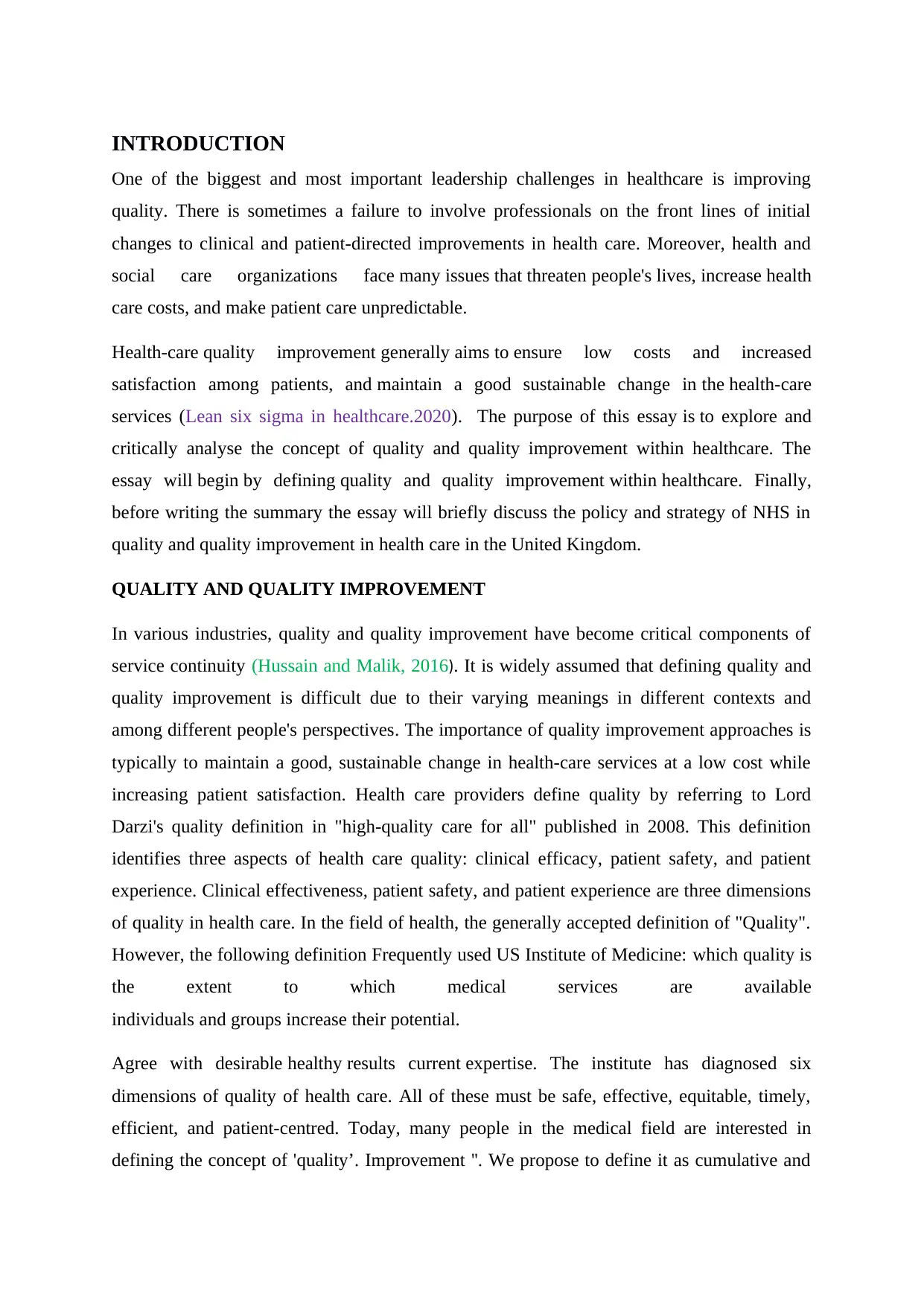
INTRODUCTION
One of the biggest and most important leadership challenges in healthcare is improving
quality. There is sometimes a failure to involve professionals on the front lines of initial
changes to clinical and patient-directed improvements in health care. Moreover, health and
social care organizations face many issues that threaten people's lives, increase health
care costs, and make patient care unpredictable.
Health-care quality improvement generally aims to ensure low costs and increased
satisfaction among patients, and maintain a good sustainable change in the health-care
services (Lean six sigma in healthcare.2020). The purpose of this essay is to explore and
critically analyse the concept of quality and quality improvement within healthcare. The
essay will begin by defining quality and quality improvement within healthcare. Finally,
before writing the summary the essay will briefly discuss the policy and strategy of NHS in
quality and quality improvement in health care in the United Kingdom.
QUALITY AND QUALITY IMPROVEMENT
In various industries, quality and quality improvement have become critical components of
service continuity (Hussain and Malik, 2016). It is widely assumed that defining quality and
quality improvement is difficult due to their varying meanings in different contexts and
among different people's perspectives. The importance of quality improvement approaches is
typically to maintain a good, sustainable change in health-care services at a low cost while
increasing patient satisfaction. Health care providers define quality by referring to Lord
Darzi's quality definition in "high-quality care for all" published in 2008. This definition
identifies three aspects of health care quality: clinical efficacy, patient safety, and patient
experience. Clinical effectiveness, patient safety, and patient experience are three dimensions
of quality in health care. In the field of health, the generally accepted definition of "Quality".
However, the following definition Frequently used US Institute of Medicine: which quality is
the extent to which medical services are available
individuals and groups increase their potential.
Agree with desirable healthy results current expertise. The institute has diagnosed six
dimensions of quality of health care. All of these must be safe, effective, equitable, timely,
efficient, and patient-centred. Today, many people in the medical field are interested in
defining the concept of 'quality’. Improvement ''. We propose to define it as cumulative and
One of the biggest and most important leadership challenges in healthcare is improving
quality. There is sometimes a failure to involve professionals on the front lines of initial
changes to clinical and patient-directed improvements in health care. Moreover, health and
social care organizations face many issues that threaten people's lives, increase health
care costs, and make patient care unpredictable.
Health-care quality improvement generally aims to ensure low costs and increased
satisfaction among patients, and maintain a good sustainable change in the health-care
services (Lean six sigma in healthcare.2020). The purpose of this essay is to explore and
critically analyse the concept of quality and quality improvement within healthcare. The
essay will begin by defining quality and quality improvement within healthcare. Finally,
before writing the summary the essay will briefly discuss the policy and strategy of NHS in
quality and quality improvement in health care in the United Kingdom.
QUALITY AND QUALITY IMPROVEMENT
In various industries, quality and quality improvement have become critical components of
service continuity (Hussain and Malik, 2016). It is widely assumed that defining quality and
quality improvement is difficult due to their varying meanings in different contexts and
among different people's perspectives. The importance of quality improvement approaches is
typically to maintain a good, sustainable change in health-care services at a low cost while
increasing patient satisfaction. Health care providers define quality by referring to Lord
Darzi's quality definition in "high-quality care for all" published in 2008. This definition
identifies three aspects of health care quality: clinical efficacy, patient safety, and patient
experience. Clinical effectiveness, patient safety, and patient experience are three dimensions
of quality in health care. In the field of health, the generally accepted definition of "Quality".
However, the following definition Frequently used US Institute of Medicine: which quality is
the extent to which medical services are available
individuals and groups increase their potential.
Agree with desirable healthy results current expertise. The institute has diagnosed six
dimensions of quality of health care. All of these must be safe, effective, equitable, timely,
efficient, and patient-centred. Today, many people in the medical field are interested in
defining the concept of 'quality’. Improvement ''. We propose to define it as cumulative and
⊘ This is a preview!⊘
Do you want full access?
Subscribe today to unlock all pages.

Trusted by 1+ million students worldwide
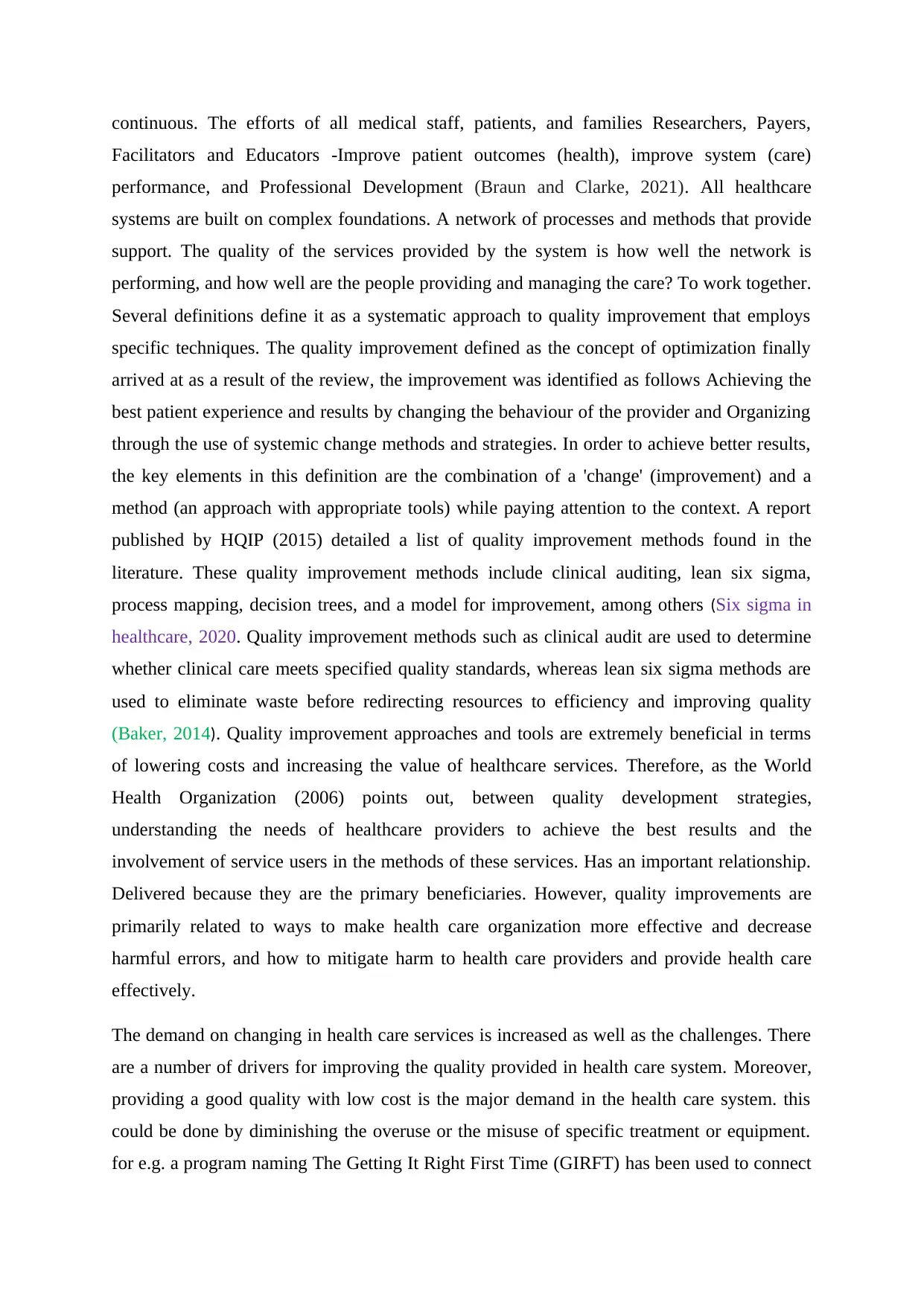
continuous. The efforts of all medical staff, patients, and families Researchers, Payers,
Facilitators and Educators -Improve patient outcomes (health), improve system (care)
performance, and Professional Development (Braun and Clarke, 2021). All healthcare
systems are built on complex foundations. A network of processes and methods that provide
support. The quality of the services provided by the system is how well the network is
performing, and how well are the people providing and managing the care? To work together.
Several definitions define it as a systematic approach to quality improvement that employs
specific techniques. The quality improvement defined as the concept of optimization finally
arrived at as a result of the review, the improvement was identified as follows Achieving the
best patient experience and results by changing the behaviour of the provider and Organizing
through the use of systemic change methods and strategies. In order to achieve better results,
the key elements in this definition are the combination of a 'change' (improvement) and a
method (an approach with appropriate tools) while paying attention to the context. A report
published by HQIP (2015) detailed a list of quality improvement methods found in the
literature. These quality improvement methods include clinical auditing, lean six sigma,
process mapping, decision trees, and a model for improvement, among others (Six sigma in
healthcare, 2020. Quality improvement methods such as clinical audit are used to determine
whether clinical care meets specified quality standards, whereas lean six sigma methods are
used to eliminate waste before redirecting resources to efficiency and improving quality
(Baker, 2014). Quality improvement approaches and tools are extremely beneficial in terms
of lowering costs and increasing the value of healthcare services. Therefore, as the World
Health Organization (2006) points out, between quality development strategies,
understanding the needs of healthcare providers to achieve the best results and the
involvement of service users in the methods of these services. Has an important relationship.
Delivered because they are the primary beneficiaries. However, quality improvements are
primarily related to ways to make health care organization more effective and decrease
harmful errors, and how to mitigate harm to health care providers and provide health care
effectively.
The demand on changing in health care services is increased as well as the challenges. There
are a number of drivers for improving the quality provided in health care system. Moreover,
providing a good quality with low cost is the major demand in the health care system. this
could be done by diminishing the overuse or the misuse of specific treatment or equipment.
for e.g. a program naming The Getting It Right First Time (GIRFT) has been used to connect
Facilitators and Educators -Improve patient outcomes (health), improve system (care)
performance, and Professional Development (Braun and Clarke, 2021). All healthcare
systems are built on complex foundations. A network of processes and methods that provide
support. The quality of the services provided by the system is how well the network is
performing, and how well are the people providing and managing the care? To work together.
Several definitions define it as a systematic approach to quality improvement that employs
specific techniques. The quality improvement defined as the concept of optimization finally
arrived at as a result of the review, the improvement was identified as follows Achieving the
best patient experience and results by changing the behaviour of the provider and Organizing
through the use of systemic change methods and strategies. In order to achieve better results,
the key elements in this definition are the combination of a 'change' (improvement) and a
method (an approach with appropriate tools) while paying attention to the context. A report
published by HQIP (2015) detailed a list of quality improvement methods found in the
literature. These quality improvement methods include clinical auditing, lean six sigma,
process mapping, decision trees, and a model for improvement, among others (Six sigma in
healthcare, 2020. Quality improvement methods such as clinical audit are used to determine
whether clinical care meets specified quality standards, whereas lean six sigma methods are
used to eliminate waste before redirecting resources to efficiency and improving quality
(Baker, 2014). Quality improvement approaches and tools are extremely beneficial in terms
of lowering costs and increasing the value of healthcare services. Therefore, as the World
Health Organization (2006) points out, between quality development strategies,
understanding the needs of healthcare providers to achieve the best results and the
involvement of service users in the methods of these services. Has an important relationship.
Delivered because they are the primary beneficiaries. However, quality improvements are
primarily related to ways to make health care organization more effective and decrease
harmful errors, and how to mitigate harm to health care providers and provide health care
effectively.
The demand on changing in health care services is increased as well as the challenges. There
are a number of drivers for improving the quality provided in health care system. Moreover,
providing a good quality with low cost is the major demand in the health care system. this
could be done by diminishing the overuse or the misuse of specific treatment or equipment.
for e.g. a program naming The Getting It Right First Time (GIRFT) has been used to connect
Paraphrase This Document
Need a fresh take? Get an instant paraphrase of this document with our AI Paraphraser

the staff and those who are responsible for delivering services with the national data about the
changes and the variations and it has been approved that applying of this program was
beneficial in the improving the value of quality (Antony and et.al, 2018). QI is fundamentally
a collaborative activity. Under the correct conditions, a team can use the information, skills,
experience, and views of its members to achieve long-term advances. A team approach is
most effective when:
• the process or system is complex
• no one individual in an organisation understands all aspects of an issue
• the process encompasses more than one field or work area
• solutions necessitate creativity; and
• staff commitment and buy-in are required.
To achieve this many strategies and roles needed to be applied for improving the quality
provided in health care system such as, making the improvement is the priority for all health
care staff in particular leadership changing for a better position in the service provided by
encouraging the health care worker, constant review of the service provided by using an
appropriate quality improving approaches, engaged patients and service received in the
equality improvement criteria, present and analyse the collected data very clearly to have a
good feedback and support any effort for progression.
However, providing a professional service quality in healthcare system is very complicated
and any issue or problem in this system required a high effort and coordination between the
organizations and the providers(Bandyopadhyay and Coppens, 2005). Moreover, limited-
resource is known as the major obstacle in quality improvement for many of business
organisation as well as the NHS. Given the escalating global economic competitiveness and
other external challenges, businesses have been pushed to embrace long-term quality and
quality management, which will boost their competitive edge. Quality has evolved
throughout time, and it now includes objective quality bordering on the characteristics and
quality of goods and services that fulfil implicit and explicit client demands. It also contains
subjective quality, which signifies the ability to produce goods and services in the most
effective, efficient, and effective way possible. In the context of health-care delivery, quality
has always been a goal since the time of Florence Nightingale. Given that quality assurance is
a requirement for economic survival as well as an issue of ethics, law, and social rights, the
changes and the variations and it has been approved that applying of this program was
beneficial in the improving the value of quality (Antony and et.al, 2018). QI is fundamentally
a collaborative activity. Under the correct conditions, a team can use the information, skills,
experience, and views of its members to achieve long-term advances. A team approach is
most effective when:
• the process or system is complex
• no one individual in an organisation understands all aspects of an issue
• the process encompasses more than one field or work area
• solutions necessitate creativity; and
• staff commitment and buy-in are required.
To achieve this many strategies and roles needed to be applied for improving the quality
provided in health care system such as, making the improvement is the priority for all health
care staff in particular leadership changing for a better position in the service provided by
encouraging the health care worker, constant review of the service provided by using an
appropriate quality improving approaches, engaged patients and service received in the
equality improvement criteria, present and analyse the collected data very clearly to have a
good feedback and support any effort for progression.
However, providing a professional service quality in healthcare system is very complicated
and any issue or problem in this system required a high effort and coordination between the
organizations and the providers(Bandyopadhyay and Coppens, 2005). Moreover, limited-
resource is known as the major obstacle in quality improvement for many of business
organisation as well as the NHS. Given the escalating global economic competitiveness and
other external challenges, businesses have been pushed to embrace long-term quality and
quality management, which will boost their competitive edge. Quality has evolved
throughout time, and it now includes objective quality bordering on the characteristics and
quality of goods and services that fulfil implicit and explicit client demands. It also contains
subjective quality, which signifies the ability to produce goods and services in the most
effective, efficient, and effective way possible. In the context of health-care delivery, quality
has always been a goal since the time of Florence Nightingale. Given that quality assurance is
a requirement for economic survival as well as an issue of ethics, law, and social rights, the
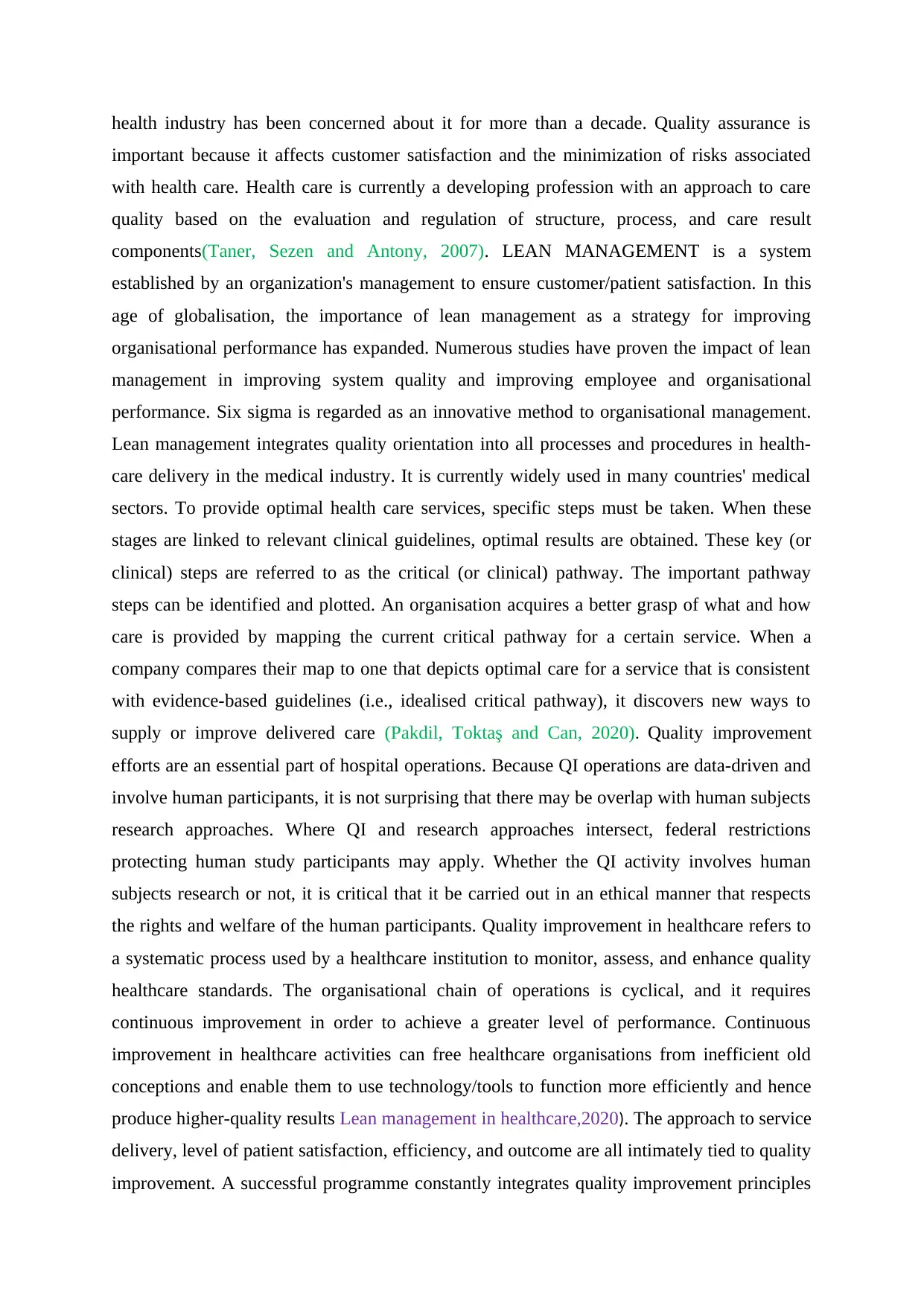
health industry has been concerned about it for more than a decade. Quality assurance is
important because it affects customer satisfaction and the minimization of risks associated
with health care. Health care is currently a developing profession with an approach to care
quality based on the evaluation and regulation of structure, process, and care result
components(Taner, Sezen and Antony, 2007). LEAN MANAGEMENT is a system
established by an organization's management to ensure customer/patient satisfaction. In this
age of globalisation, the importance of lean management as a strategy for improving
organisational performance has expanded. Numerous studies have proven the impact of lean
management in improving system quality and improving employee and organisational
performance. Six sigma is regarded as an innovative method to organisational management.
Lean management integrates quality orientation into all processes and procedures in health-
care delivery in the medical industry. It is currently widely used in many countries' medical
sectors. To provide optimal health care services, specific steps must be taken. When these
stages are linked to relevant clinical guidelines, optimal results are obtained. These key (or
clinical) steps are referred to as the critical (or clinical) pathway. The important pathway
steps can be identified and plotted. An organisation acquires a better grasp of what and how
care is provided by mapping the current critical pathway for a certain service. When a
company compares their map to one that depicts optimal care for a service that is consistent
with evidence-based guidelines (i.e., idealised critical pathway), it discovers new ways to
supply or improve delivered care (Pakdil, Toktaş and Can, 2020). Quality improvement
efforts are an essential part of hospital operations. Because QI operations are data-driven and
involve human participants, it is not surprising that there may be overlap with human subjects
research approaches. Where QI and research approaches intersect, federal restrictions
protecting human study participants may apply. Whether the QI activity involves human
subjects research or not, it is critical that it be carried out in an ethical manner that respects
the rights and welfare of the human participants. Quality improvement in healthcare refers to
a systematic process used by a healthcare institution to monitor, assess, and enhance quality
healthcare standards. The organisational chain of operations is cyclical, and it requires
continuous improvement in order to achieve a greater level of performance. Continuous
improvement in healthcare activities can free healthcare organisations from inefficient old
conceptions and enable them to use technology/tools to function more efficiently and hence
produce higher-quality results Lean management in healthcare,2020). The approach to service
delivery, level of patient satisfaction, efficiency, and outcome are all intimately tied to quality
improvement. A successful programme constantly integrates quality improvement principles
important because it affects customer satisfaction and the minimization of risks associated
with health care. Health care is currently a developing profession with an approach to care
quality based on the evaluation and regulation of structure, process, and care result
components(Taner, Sezen and Antony, 2007). LEAN MANAGEMENT is a system
established by an organization's management to ensure customer/patient satisfaction. In this
age of globalisation, the importance of lean management as a strategy for improving
organisational performance has expanded. Numerous studies have proven the impact of lean
management in improving system quality and improving employee and organisational
performance. Six sigma is regarded as an innovative method to organisational management.
Lean management integrates quality orientation into all processes and procedures in health-
care delivery in the medical industry. It is currently widely used in many countries' medical
sectors. To provide optimal health care services, specific steps must be taken. When these
stages are linked to relevant clinical guidelines, optimal results are obtained. These key (or
clinical) steps are referred to as the critical (or clinical) pathway. The important pathway
steps can be identified and plotted. An organisation acquires a better grasp of what and how
care is provided by mapping the current critical pathway for a certain service. When a
company compares their map to one that depicts optimal care for a service that is consistent
with evidence-based guidelines (i.e., idealised critical pathway), it discovers new ways to
supply or improve delivered care (Pakdil, Toktaş and Can, 2020). Quality improvement
efforts are an essential part of hospital operations. Because QI operations are data-driven and
involve human participants, it is not surprising that there may be overlap with human subjects
research approaches. Where QI and research approaches intersect, federal restrictions
protecting human study participants may apply. Whether the QI activity involves human
subjects research or not, it is critical that it be carried out in an ethical manner that respects
the rights and welfare of the human participants. Quality improvement in healthcare refers to
a systematic process used by a healthcare institution to monitor, assess, and enhance quality
healthcare standards. The organisational chain of operations is cyclical, and it requires
continuous improvement in order to achieve a greater level of performance. Continuous
improvement in healthcare activities can free healthcare organisations from inefficient old
conceptions and enable them to use technology/tools to function more efficiently and hence
produce higher-quality results Lean management in healthcare,2020). The approach to service
delivery, level of patient satisfaction, efficiency, and outcome are all intimately tied to quality
improvement. A successful programme constantly integrates quality improvement principles
⊘ This is a preview!⊘
Do you want full access?
Subscribe today to unlock all pages.

Trusted by 1+ million students worldwide
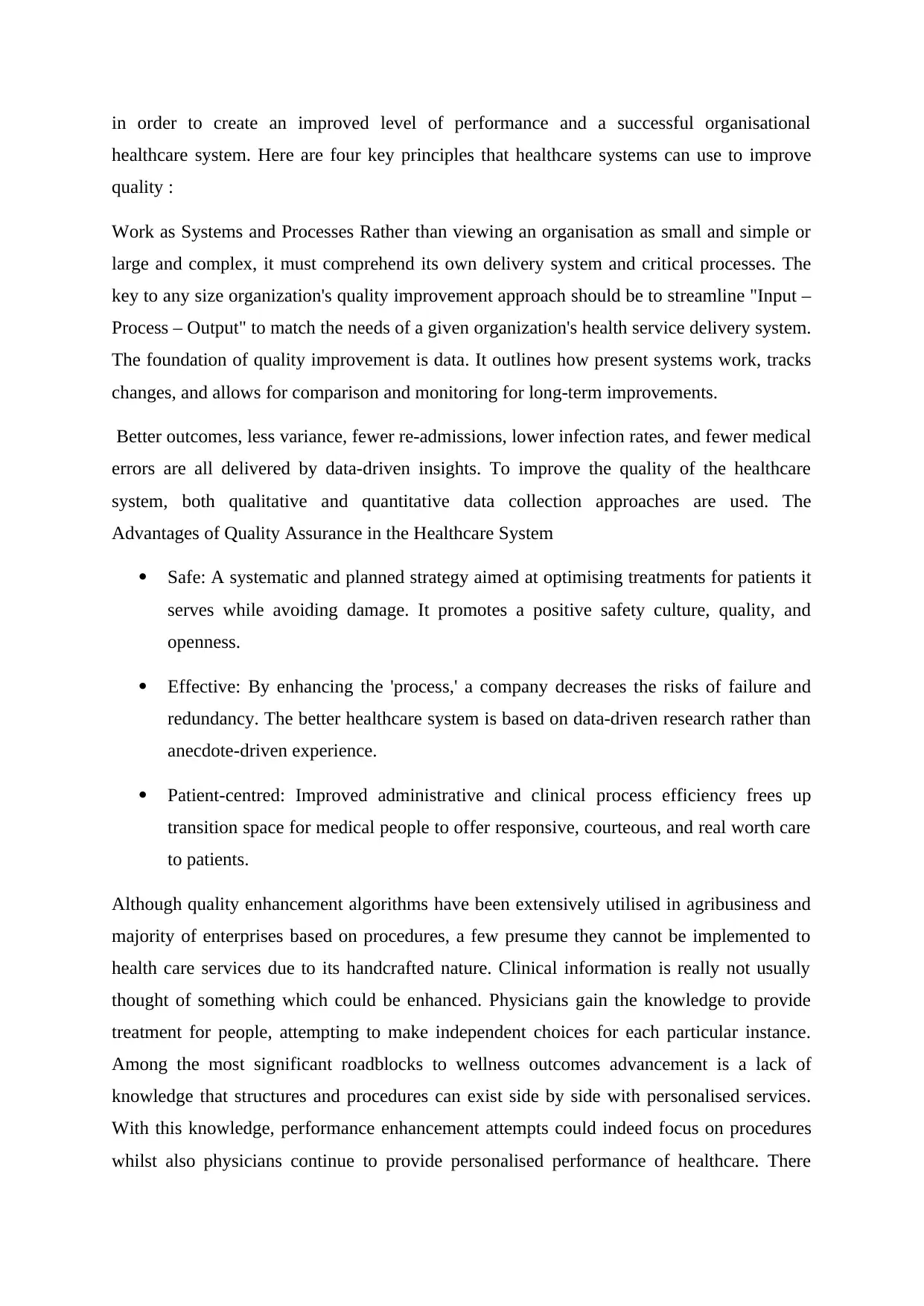
in order to create an improved level of performance and a successful organisational
healthcare system. Here are four key principles that healthcare systems can use to improve
quality :
Work as Systems and Processes Rather than viewing an organisation as small and simple or
large and complex, it must comprehend its own delivery system and critical processes. The
key to any size organization's quality improvement approach should be to streamline "Input –
Process – Output" to match the needs of a given organization's health service delivery system.
The foundation of quality improvement is data. It outlines how present systems work, tracks
changes, and allows for comparison and monitoring for long-term improvements.
Better outcomes, less variance, fewer re-admissions, lower infection rates, and fewer medical
errors are all delivered by data-driven insights. To improve the quality of the healthcare
system, both qualitative and quantitative data collection approaches are used. The
Advantages of Quality Assurance in the Healthcare System
Safe: A systematic and planned strategy aimed at optimising treatments for patients it
serves while avoiding damage. It promotes a positive safety culture, quality, and
openness.
Effective: By enhancing the 'process,' a company decreases the risks of failure and
redundancy. The better healthcare system is based on data-driven research rather than
anecdote-driven experience.
Patient-centred: Improved administrative and clinical process efficiency frees up
transition space for medical people to offer responsive, courteous, and real worth care
to patients.
Although quality enhancement algorithms have been extensively utilised in agribusiness and
majority of enterprises based on procedures, a few presume they cannot be implemented to
health care services due to its handcrafted nature. Clinical information is really not usually
thought of something which could be enhanced. Physicians gain the knowledge to provide
treatment for people, attempting to make independent choices for each particular instance.
Among the most significant roadblocks to wellness outcomes advancement is a lack of
knowledge that structures and procedures can exist side by side with personalised services.
With this knowledge, performance enhancement attempts could indeed focus on procedures
whilst also physicians continue to provide personalised performance of healthcare. There
healthcare system. Here are four key principles that healthcare systems can use to improve
quality :
Work as Systems and Processes Rather than viewing an organisation as small and simple or
large and complex, it must comprehend its own delivery system and critical processes. The
key to any size organization's quality improvement approach should be to streamline "Input –
Process – Output" to match the needs of a given organization's health service delivery system.
The foundation of quality improvement is data. It outlines how present systems work, tracks
changes, and allows for comparison and monitoring for long-term improvements.
Better outcomes, less variance, fewer re-admissions, lower infection rates, and fewer medical
errors are all delivered by data-driven insights. To improve the quality of the healthcare
system, both qualitative and quantitative data collection approaches are used. The
Advantages of Quality Assurance in the Healthcare System
Safe: A systematic and planned strategy aimed at optimising treatments for patients it
serves while avoiding damage. It promotes a positive safety culture, quality, and
openness.
Effective: By enhancing the 'process,' a company decreases the risks of failure and
redundancy. The better healthcare system is based on data-driven research rather than
anecdote-driven experience.
Patient-centred: Improved administrative and clinical process efficiency frees up
transition space for medical people to offer responsive, courteous, and real worth care
to patients.
Although quality enhancement algorithms have been extensively utilised in agribusiness and
majority of enterprises based on procedures, a few presume they cannot be implemented to
health care services due to its handcrafted nature. Clinical information is really not usually
thought of something which could be enhanced. Physicians gain the knowledge to provide
treatment for people, attempting to make independent choices for each particular instance.
Among the most significant roadblocks to wellness outcomes advancement is a lack of
knowledge that structures and procedures can exist side by side with personalised services.
With this knowledge, performance enhancement attempts could indeed focus on procedures
whilst also physicians continue to provide personalised performance of healthcare. There
Paraphrase This Document
Need a fresh take? Get an instant paraphrase of this document with our AI Paraphraser
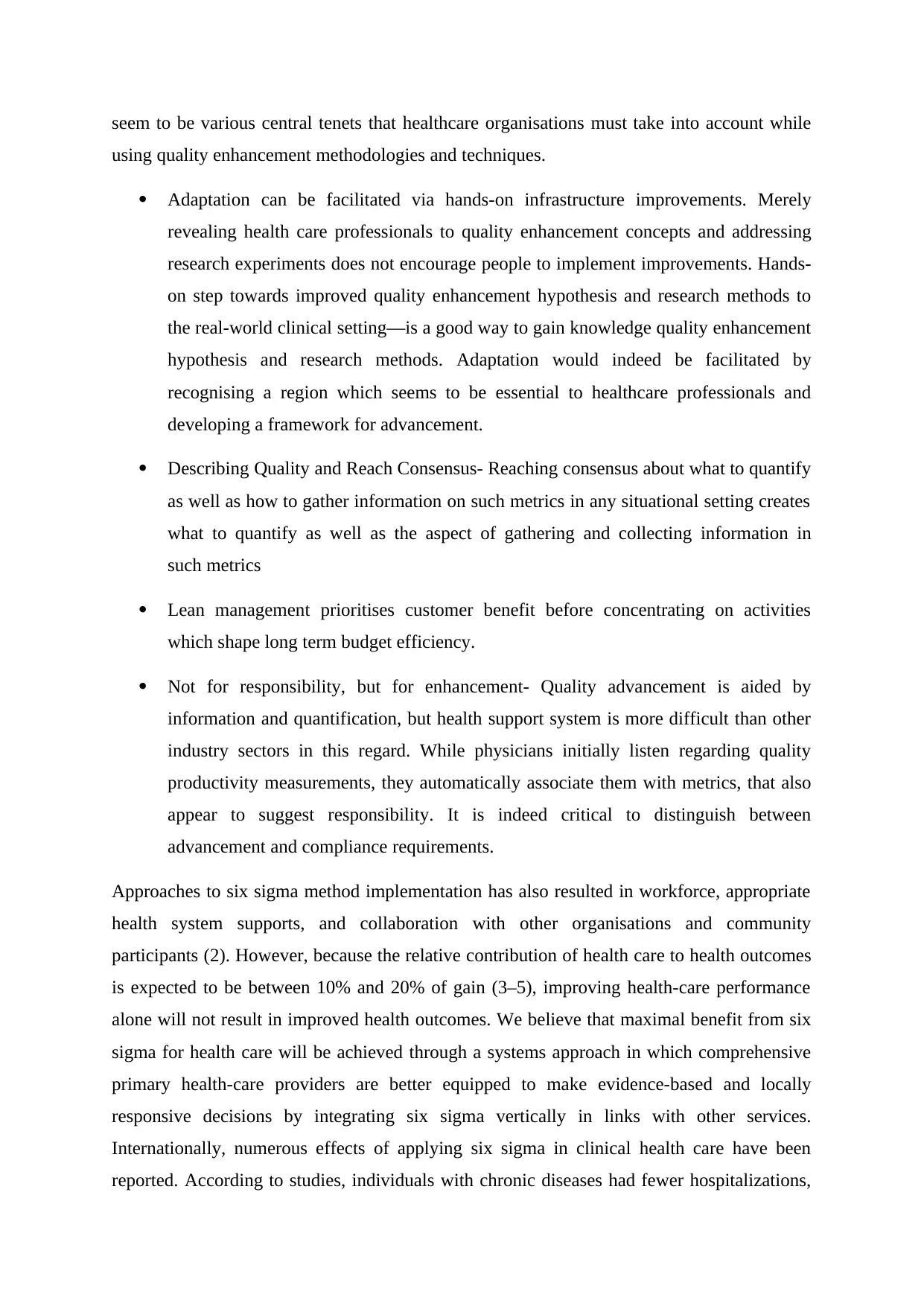
seem to be various central tenets that healthcare organisations must take into account while
using quality enhancement methodologies and techniques.
Adaptation can be facilitated via hands-on infrastructure improvements. Merely
revealing health care professionals to quality enhancement concepts and addressing
research experiments does not encourage people to implement improvements. Hands-
on step towards improved quality enhancement hypothesis and research methods to
the real-world clinical setting—is a good way to gain knowledge quality enhancement
hypothesis and research methods. Adaptation would indeed be facilitated by
recognising a region which seems to be essential to healthcare professionals and
developing a framework for advancement.
Describing Quality and Reach Consensus- Reaching consensus about what to quantify
as well as how to gather information on such metrics in any situational setting creates
what to quantify as well as the aspect of gathering and collecting information in
such metrics
Lean management prioritises customer benefit before concentrating on activities
which shape long term budget efficiency.
Not for responsibility, but for enhancement- Quality advancement is aided by
information and quantification, but health support system is more difficult than other
industry sectors in this regard. While physicians initially listen regarding quality
productivity measurements, they automatically associate them with metrics, that also
appear to suggest responsibility. It is indeed critical to distinguish between
advancement and compliance requirements.
Approaches to six sigma method implementation has also resulted in workforce, appropriate
health system supports, and collaboration with other organisations and community
participants (2). However, because the relative contribution of health care to health outcomes
is expected to be between 10% and 20% of gain (3–5), improving health-care performance
alone will not result in improved health outcomes. We believe that maximal benefit from six
sigma for health care will be achieved through a systems approach in which comprehensive
primary health-care providers are better equipped to make evidence-based and locally
responsive decisions by integrating six sigma vertically in links with other services.
Internationally, numerous effects of applying six sigma in clinical health care have been
reported. According to studies, individuals with chronic diseases had fewer hospitalizations,
using quality enhancement methodologies and techniques.
Adaptation can be facilitated via hands-on infrastructure improvements. Merely
revealing health care professionals to quality enhancement concepts and addressing
research experiments does not encourage people to implement improvements. Hands-
on step towards improved quality enhancement hypothesis and research methods to
the real-world clinical setting—is a good way to gain knowledge quality enhancement
hypothesis and research methods. Adaptation would indeed be facilitated by
recognising a region which seems to be essential to healthcare professionals and
developing a framework for advancement.
Describing Quality and Reach Consensus- Reaching consensus about what to quantify
as well as how to gather information on such metrics in any situational setting creates
what to quantify as well as the aspect of gathering and collecting information in
such metrics
Lean management prioritises customer benefit before concentrating on activities
which shape long term budget efficiency.
Not for responsibility, but for enhancement- Quality advancement is aided by
information and quantification, but health support system is more difficult than other
industry sectors in this regard. While physicians initially listen regarding quality
productivity measurements, they automatically associate them with metrics, that also
appear to suggest responsibility. It is indeed critical to distinguish between
advancement and compliance requirements.
Approaches to six sigma method implementation has also resulted in workforce, appropriate
health system supports, and collaboration with other organisations and community
participants (2). However, because the relative contribution of health care to health outcomes
is expected to be between 10% and 20% of gain (3–5), improving health-care performance
alone will not result in improved health outcomes. We believe that maximal benefit from six
sigma for health care will be achieved through a systems approach in which comprehensive
primary health-care providers are better equipped to make evidence-based and locally
responsive decisions by integrating six sigma vertically in links with other services.
Internationally, numerous effects of applying six sigma in clinical health care have been
reported. According to studies, individuals with chronic diseases had fewer hospitalizations,
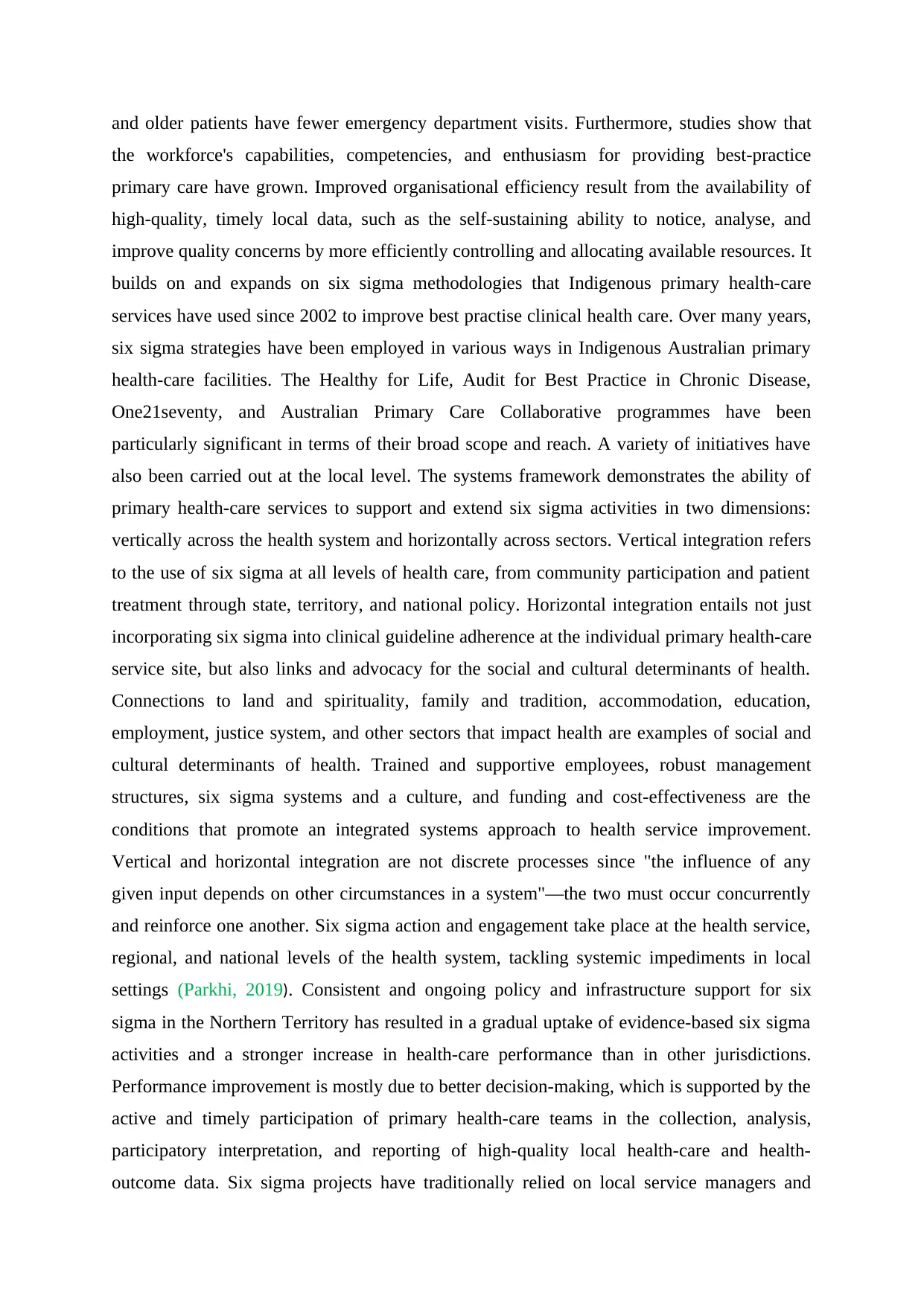
and older patients have fewer emergency department visits. Furthermore, studies show that
the workforce's capabilities, competencies, and enthusiasm for providing best-practice
primary care have grown. Improved organisational efficiency result from the availability of
high-quality, timely local data, such as the self-sustaining ability to notice, analyse, and
improve quality concerns by more efficiently controlling and allocating available resources. It
builds on and expands on six sigma methodologies that Indigenous primary health-care
services have used since 2002 to improve best practise clinical health care. Over many years,
six sigma strategies have been employed in various ways in Indigenous Australian primary
health-care facilities. The Healthy for Life, Audit for Best Practice in Chronic Disease,
One21seventy, and Australian Primary Care Collaborative programmes have been
particularly significant in terms of their broad scope and reach. A variety of initiatives have
also been carried out at the local level. The systems framework demonstrates the ability of
primary health-care services to support and extend six sigma activities in two dimensions:
vertically across the health system and horizontally across sectors. Vertical integration refers
to the use of six sigma at all levels of health care, from community participation and patient
treatment through state, territory, and national policy. Horizontal integration entails not just
incorporating six sigma into clinical guideline adherence at the individual primary health-care
service site, but also links and advocacy for the social and cultural determinants of health.
Connections to land and spirituality, family and tradition, accommodation, education,
employment, justice system, and other sectors that impact health are examples of social and
cultural determinants of health. Trained and supportive employees, robust management
structures, six sigma systems and a culture, and funding and cost-effectiveness are the
conditions that promote an integrated systems approach to health service improvement.
Vertical and horizontal integration are not discrete processes since "the influence of any
given input depends on other circumstances in a system"—the two must occur concurrently
and reinforce one another. Six sigma action and engagement take place at the health service,
regional, and national levels of the health system, tackling systemic impediments in local
settings (Parkhi, 2019). Consistent and ongoing policy and infrastructure support for six
sigma in the Northern Territory has resulted in a gradual uptake of evidence-based six sigma
activities and a stronger increase in health-care performance than in other jurisdictions.
Performance improvement is mostly due to better decision-making, which is supported by the
active and timely participation of primary health-care teams in the collection, analysis,
participatory interpretation, and reporting of high-quality local health-care and health-
outcome data. Six sigma projects have traditionally relied on local service managers and
the workforce's capabilities, competencies, and enthusiasm for providing best-practice
primary care have grown. Improved organisational efficiency result from the availability of
high-quality, timely local data, such as the self-sustaining ability to notice, analyse, and
improve quality concerns by more efficiently controlling and allocating available resources. It
builds on and expands on six sigma methodologies that Indigenous primary health-care
services have used since 2002 to improve best practise clinical health care. Over many years,
six sigma strategies have been employed in various ways in Indigenous Australian primary
health-care facilities. The Healthy for Life, Audit for Best Practice in Chronic Disease,
One21seventy, and Australian Primary Care Collaborative programmes have been
particularly significant in terms of their broad scope and reach. A variety of initiatives have
also been carried out at the local level. The systems framework demonstrates the ability of
primary health-care services to support and extend six sigma activities in two dimensions:
vertically across the health system and horizontally across sectors. Vertical integration refers
to the use of six sigma at all levels of health care, from community participation and patient
treatment through state, territory, and national policy. Horizontal integration entails not just
incorporating six sigma into clinical guideline adherence at the individual primary health-care
service site, but also links and advocacy for the social and cultural determinants of health.
Connections to land and spirituality, family and tradition, accommodation, education,
employment, justice system, and other sectors that impact health are examples of social and
cultural determinants of health. Trained and supportive employees, robust management
structures, six sigma systems and a culture, and funding and cost-effectiveness are the
conditions that promote an integrated systems approach to health service improvement.
Vertical and horizontal integration are not discrete processes since "the influence of any
given input depends on other circumstances in a system"—the two must occur concurrently
and reinforce one another. Six sigma action and engagement take place at the health service,
regional, and national levels of the health system, tackling systemic impediments in local
settings (Parkhi, 2019). Consistent and ongoing policy and infrastructure support for six
sigma in the Northern Territory has resulted in a gradual uptake of evidence-based six sigma
activities and a stronger increase in health-care performance than in other jurisdictions.
Performance improvement is mostly due to better decision-making, which is supported by the
active and timely participation of primary health-care teams in the collection, analysis,
participatory interpretation, and reporting of high-quality local health-care and health-
outcome data. Six sigma projects have traditionally relied on local service managers and
⊘ This is a preview!⊘
Do you want full access?
Subscribe today to unlock all pages.

Trusted by 1+ million students worldwide

physicians, with quality improvement efforts impeded by a lack of localised and accurate
health-care performance data. However, significant development work has been done in
recent years, and a national six sigma framework for Indigenous country primary health care
is in the final stages of consultation. Its impending release and implementation should draw
attention to how consistent policy and infrastructural support can be preserved to enable
widespread adoption of six sigma activities.
Improving patient experience and happiness requires ensuring quality and safety in
healthcare. Healthcare process improvement refers to the deliberate quality increases made to
all related functions, with a strong emphasis on patient happiness. While drafting this, the
hospital administration must prioritise the staff and the healthcare facilities supplied, as well
as the practical demands and ambitions of the patients and their relatives. Because managers
and personnel in the healthcare sector will be in direct contact with patients, there must be a
strong emphasis on 'lean manufacturing.'
Cost reduction is critical in order to deliver cheap healthcare services to patients while also
profiting healthcare providers. Patients expect to receive quality care in hospitals, and when
this does not occur, patient satisfaction suffers. If hospital administration aims to boost
patient satisfaction, the cost-cutting procedure should be carried out methodically without
jeopardising healthcare quality and safety (Prado-Prado and et.al, 2020). The technique we
generally advocate is a systematic evaluation of the present organisational functioning style
and the deployment of strategic cost management. Quality management in healthcare is
impractical unless the throughput time is effectively and competently managed. In the
healthcare industry, throughput time refers to the total amount of time required to accomplish
the relevant therapeutic duties precisely and on time, so that patients feel at ease throughout
their outpatient appointment as well as their routine check-up. This encompasses all functions
related to the patients' points of interaction with the hospital. It is critical to manage
throughput time wisely in order to improve quality and safety in healthcare. This will restore
the hospital's credibility and friendliness. The productivity and performance of the workforce
are two critical areas on which management must focus in order to implement quality
management in healthcare. These two components are critical and will have an impact on the
outcome of the healthcare service. Productivity and performance are inextricably related. We
aid in developing and establishing the benchmarks against which the performance monitoring
committee will analyse, monitor, and verify the performance and productivity of the
personnel.
health-care performance data. However, significant development work has been done in
recent years, and a national six sigma framework for Indigenous country primary health care
is in the final stages of consultation. Its impending release and implementation should draw
attention to how consistent policy and infrastructural support can be preserved to enable
widespread adoption of six sigma activities.
Improving patient experience and happiness requires ensuring quality and safety in
healthcare. Healthcare process improvement refers to the deliberate quality increases made to
all related functions, with a strong emphasis on patient happiness. While drafting this, the
hospital administration must prioritise the staff and the healthcare facilities supplied, as well
as the practical demands and ambitions of the patients and their relatives. Because managers
and personnel in the healthcare sector will be in direct contact with patients, there must be a
strong emphasis on 'lean manufacturing.'
Cost reduction is critical in order to deliver cheap healthcare services to patients while also
profiting healthcare providers. Patients expect to receive quality care in hospitals, and when
this does not occur, patient satisfaction suffers. If hospital administration aims to boost
patient satisfaction, the cost-cutting procedure should be carried out methodically without
jeopardising healthcare quality and safety (Prado-Prado and et.al, 2020). The technique we
generally advocate is a systematic evaluation of the present organisational functioning style
and the deployment of strategic cost management. Quality management in healthcare is
impractical unless the throughput time is effectively and competently managed. In the
healthcare industry, throughput time refers to the total amount of time required to accomplish
the relevant therapeutic duties precisely and on time, so that patients feel at ease throughout
their outpatient appointment as well as their routine check-up. This encompasses all functions
related to the patients' points of interaction with the hospital. It is critical to manage
throughput time wisely in order to improve quality and safety in healthcare. This will restore
the hospital's credibility and friendliness. The productivity and performance of the workforce
are two critical areas on which management must focus in order to implement quality
management in healthcare. These two components are critical and will have an impact on the
outcome of the healthcare service. Productivity and performance are inextricably related. We
aid in developing and establishing the benchmarks against which the performance monitoring
committee will analyse, monitor, and verify the performance and productivity of the
personnel.
Paraphrase This Document
Need a fresh take? Get an instant paraphrase of this document with our AI Paraphraser
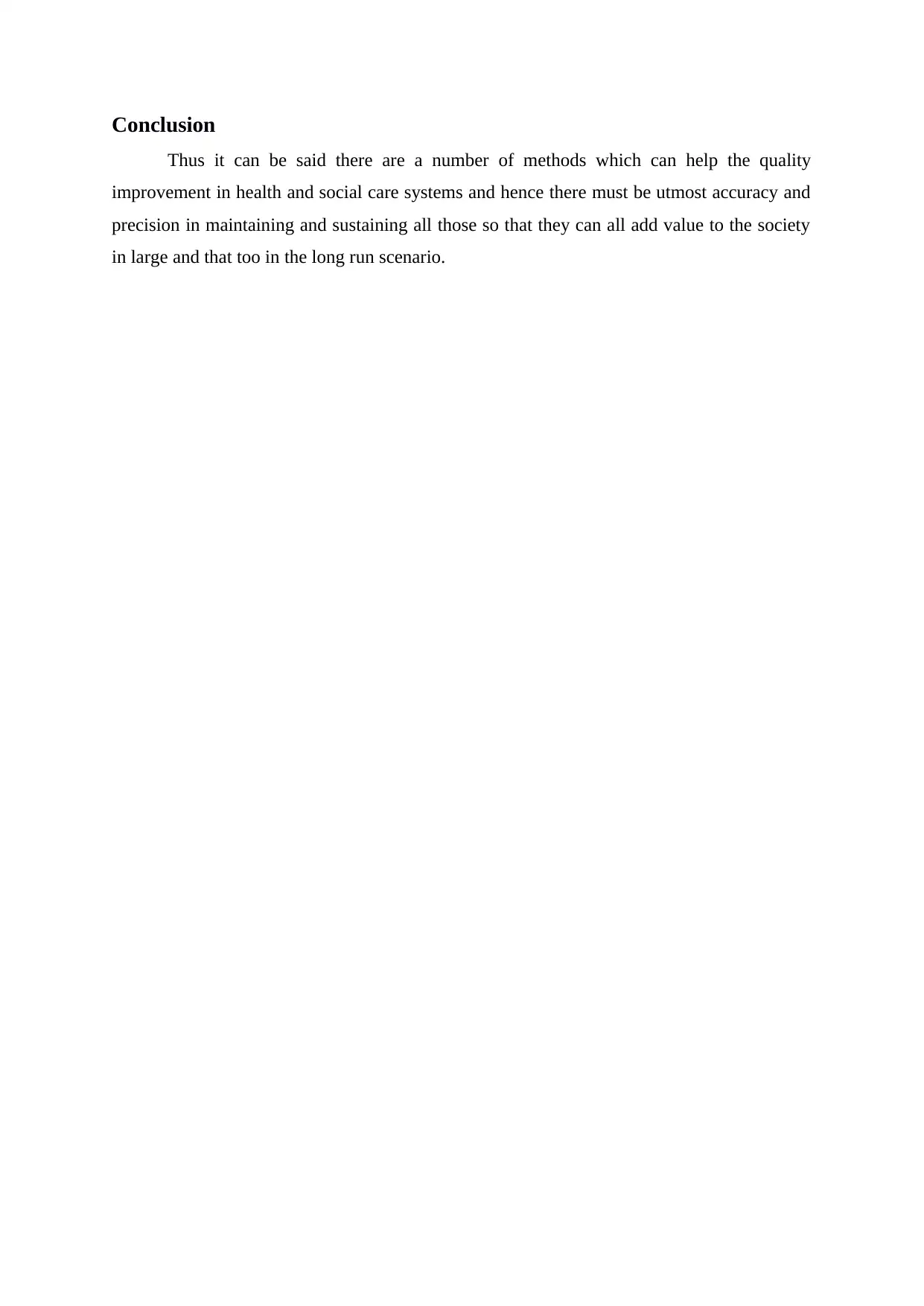
Conclusion
Thus it can be said there are a number of methods which can help the quality
improvement in health and social care systems and hence there must be utmost accuracy and
precision in maintaining and sustaining all those so that they can all add value to the society
in large and that too in the long run scenario.
Thus it can be said there are a number of methods which can help the quality
improvement in health and social care systems and hence there must be utmost accuracy and
precision in maintaining and sustaining all those so that they can all add value to the society
in large and that too in the long run scenario.
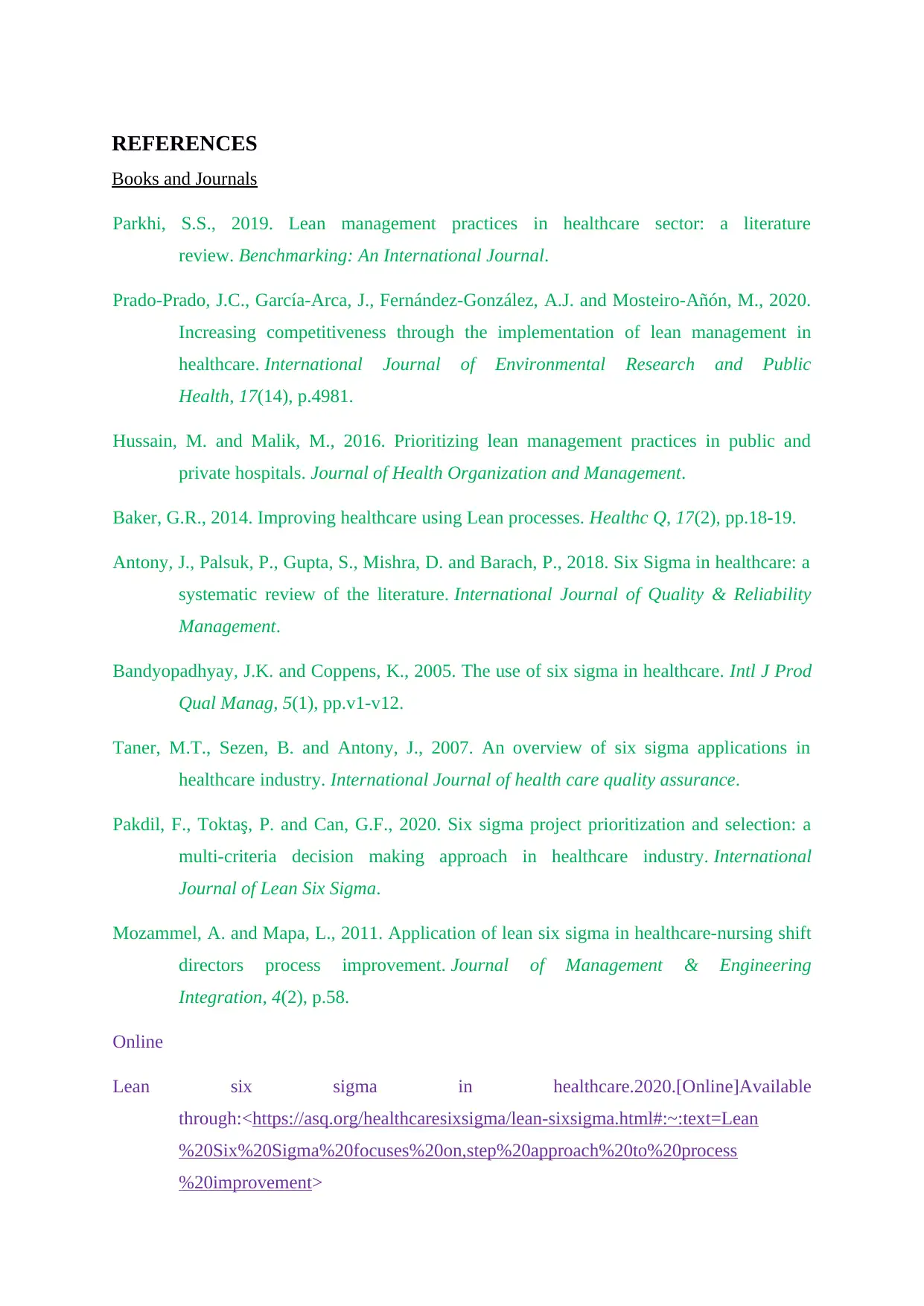
REFERENCES
Books and Journals
Parkhi, S.S., 2019. Lean management practices in healthcare sector: a literature
review. Benchmarking: An International Journal.
Prado-Prado, J.C., García-Arca, J., Fernández-González, A.J. and Mosteiro-Añón, M., 2020.
Increasing competitiveness through the implementation of lean management in
healthcare. International Journal of Environmental Research and Public
Health, 17(14), p.4981.
Hussain, M. and Malik, M., 2016. Prioritizing lean management practices in public and
private hospitals. Journal of Health Organization and Management.
Baker, G.R., 2014. Improving healthcare using Lean processes. Healthc Q, 17(2), pp.18-19.
Antony, J., Palsuk, P., Gupta, S., Mishra, D. and Barach, P., 2018. Six Sigma in healthcare: a
systematic review of the literature. International Journal of Quality & Reliability
Management.
Bandyopadhyay, J.K. and Coppens, K., 2005. The use of six sigma in healthcare. Intl J Prod
Qual Manag, 5(1), pp.v1-v12.
Taner, M.T., Sezen, B. and Antony, J., 2007. An overview of six sigma applications in
healthcare industry. International Journal of health care quality assurance.
Pakdil, F., Toktaş, P. and Can, G.F., 2020. Six sigma project prioritization and selection: a
multi-criteria decision making approach in healthcare industry. International
Journal of Lean Six Sigma.
Mozammel, A. and Mapa, L., 2011. Application of lean six sigma in healthcare-nursing shift
directors process improvement. Journal of Management & Engineering
Integration, 4(2), p.58.
Online
Lean six sigma in healthcare.2020.[Online]Available
through:<https://asq.org/healthcaresixsigma/lean-sixsigma.html#:~:text=Lean
%20Six%20Sigma%20focuses%20on,step%20approach%20to%20process
%20improvement>
Books and Journals
Parkhi, S.S., 2019. Lean management practices in healthcare sector: a literature
review. Benchmarking: An International Journal.
Prado-Prado, J.C., García-Arca, J., Fernández-González, A.J. and Mosteiro-Añón, M., 2020.
Increasing competitiveness through the implementation of lean management in
healthcare. International Journal of Environmental Research and Public
Health, 17(14), p.4981.
Hussain, M. and Malik, M., 2016. Prioritizing lean management practices in public and
private hospitals. Journal of Health Organization and Management.
Baker, G.R., 2014. Improving healthcare using Lean processes. Healthc Q, 17(2), pp.18-19.
Antony, J., Palsuk, P., Gupta, S., Mishra, D. and Barach, P., 2018. Six Sigma in healthcare: a
systematic review of the literature. International Journal of Quality & Reliability
Management.
Bandyopadhyay, J.K. and Coppens, K., 2005. The use of six sigma in healthcare. Intl J Prod
Qual Manag, 5(1), pp.v1-v12.
Taner, M.T., Sezen, B. and Antony, J., 2007. An overview of six sigma applications in
healthcare industry. International Journal of health care quality assurance.
Pakdil, F., Toktaş, P. and Can, G.F., 2020. Six sigma project prioritization and selection: a
multi-criteria decision making approach in healthcare industry. International
Journal of Lean Six Sigma.
Mozammel, A. and Mapa, L., 2011. Application of lean six sigma in healthcare-nursing shift
directors process improvement. Journal of Management & Engineering
Integration, 4(2), p.58.
Online
Lean six sigma in healthcare.2020.[Online]Available
through:<https://asq.org/healthcaresixsigma/lean-sixsigma.html#:~:text=Lean
%20Six%20Sigma%20focuses%20on,step%20approach%20to%20process
%20improvement>
⊘ This is a preview!⊘
Do you want full access?
Subscribe today to unlock all pages.

Trusted by 1+ million students worldwide
1 out of 13
Related Documents
Your All-in-One AI-Powered Toolkit for Academic Success.
+13062052269
info@desklib.com
Available 24*7 on WhatsApp / Email
![[object Object]](/_next/static/media/star-bottom.7253800d.svg)
Unlock your academic potential
Copyright © 2020–2025 A2Z Services. All Rights Reserved. Developed and managed by ZUCOL.




